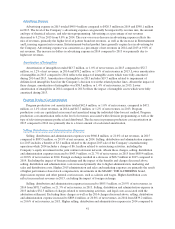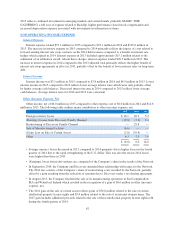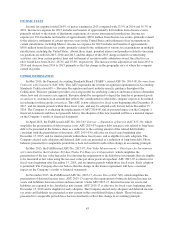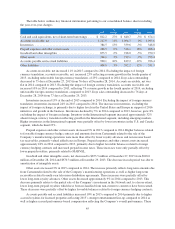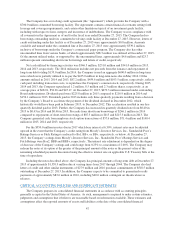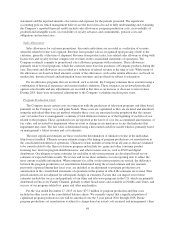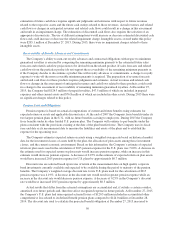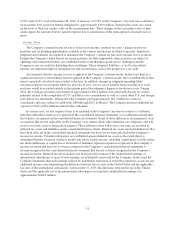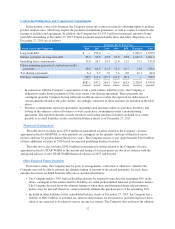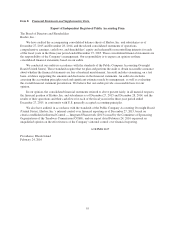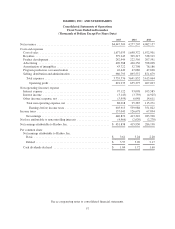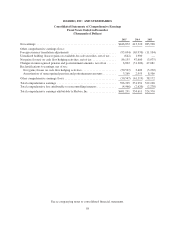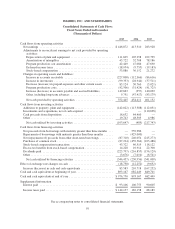Hasbro 2015 Annual Report Download - page 60
Download and view the complete annual report
Please find page 60 of the 2015 Hasbro annual report below. You can navigate through the pages in the report by either clicking on the pages listed below, or by using the keyword search tool below to find specific information within the annual report.
current estimates of ultimate revenues. During 2014 and 2013 the Company recorded accelerated amortization on
certain television programming based on revised ultimate expected revenues.
Recoverability of Goodwill and Intangible Assets
Goodwill and other intangible assets deemed to have indefinite lives are tested for impairment at least
annually. If an event occurs or circumstances change that indicate that the carrying value may not be recoverable,
the Company will perform an interim test at that time. The Company may perform a qualitative assessment and
bypass the quantitative two-step impairment process if it is not more likely than not that impairment exists.
Performing a qualitative assessment of goodwill requires a high degree of judgment regarding assumptions
underlying the valuation. Qualitative factors and their impact on critical inputs are assessed to determine whether
it is more likely than not that the fair value of a reporting unit is less than its carrying value. If it is more likely
than not that impairment exists, the quantitative two-step goodwill impairment test is performed. When
performing the quantitative two-step impairment test, goodwill and other intangible assets with indefinite lives
are tested for impairment by comparing their carrying value to their estimated fair value which is calculated
using an income approach. During the fourth quarter of 2015, the Company performed a qualitative assessment
with respect to certain of its reporting units with goodwill totaling $473.6 million. The Company utilized this
approach for all reporting units with the exception of Backflip based on the amount by which historical estimated
reporting unit fair values exceeded carrying values. Based on its qualitative assessment, the Company concluded
that there was no impairment of this goodwill during 2015. The Company has $119.1 million of goodwill related
to its 2013 acquisition of Backflip, which represents a separate reporting unit. The Company’s strategy when it
purchased its interest in Backflip was to produce game titles based on Backflip’s DRAGONVALE brand and to
develop and market games based on Hasbro brands. Because Backflip was a recent acquisition and to date has
been investment spending in anticipation of 2016 game releases, the Company performed the quantitative two-
step impairment test during the fourth quarter of 2015 for this reporting unit. The impairment test utilized cash
flows expected to be generated from mobile gaming offerings, including 2016 releases based on Backflip’s
DRAGONVALE brand, as well as several Hasbro branded-game titles. The underlying cash flows are based on
long-term financial plans for Backflip, which include projections for growth in revenues and profitability. The
Company used a discount rate commensurate with the digital gaming industry. Based on the results of the
impairment test, the Company concluded that there was no impairment as the estimated fair value of the
reporting unit exceeded its carrying value. The fair value would have to decline by 20% in order for this asset to
be impaired. Should Backflip not achieve its profitability and growth targets, including the anticipated game
releases in 2016, or if industry discount rates significantly increase, the carrying value of this reporting unit may
become impaired.
The Company also performed quantitative annual impairment tests related to intangible assets totaling $75.7
million with indefinite lives in the fourth quarter of 2015 and no impairments were indicated as the estimated fair
values were substantially in excess of the carrying values of the related assets.
The estimation of future cash flows utilized in the evaluation of the Company’s goodwill and indefinite
lived intangibles requires significant judgments and estimates with respect to future revenues related to the
respective asset and the future cash outlays related to those revenues. Actual revenues and related cash flows or
changes in anticipated revenues and related cash flows could result in a change in this assessment and result in an
impairment charge. The estimation of discounted cash flows also requires the selection of an appropriate discount
rate. The use of different assumptions would increase or decrease estimated discounted cash flows and could
increase or decrease the related impairment charge.
Intangible assets, other than those with indefinite lives, are amortized over their estimated useful lives and
are reviewed for indications of impairment whenever events or changes in circumstances indicate the carrying
value may not be recoverable. Recoverability of the value of these intangible assets is measured by a comparison
of the assets’ carrying value to the estimated future undiscounted cash flows expected to be generated by the
assets. If such assets were considered to be impaired, the impairment would be measured by the amount by which
the carrying value of the assets exceeds its fair value based on estimated future discounted cash flows. The
49




